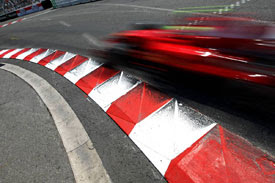on frow again

Felipe Massa will start tomorrow's Monaco Grand Prix from pole position after snatching the top spot from Ferrari teammate Kimi Raikkonen by less than three hundredths of a second.
Ferrari locked out the front row, despite McLaren having looked quicker throughout the weekend so far. Lewis Hamilton and Heikki Kovalainen had to settle for sharing the second row of the grid.
Hamilton and Kovalainen began qualifying by trading quickest times in Q1, but Massa pulled a 1:15.1 out of the bag in the dying seconds. The Brazilian repeated the time with his first effort in Q2 and it remained unbeaten as he went on to top all three parts of qualifying.
Raikkonen seemed to have secured pole position when his last effort proved just out of reach of Hamilton, but Massa, last on track again, stole the top spot by the smallest of margins with the final lap of the session.
The McLarens were quickest in the first sector, but lost out ultimately because they weren't able to match the pace of the Ferraris in the longer second sector of the lap.
Robert Kubica was best of the rest in fifth place, ahead of Nico Rosberg, who finished Q2 in second place after setting an excellent 1:15.287 on the harder tyre.
Fernando Alonso will start seventh after only just making it into the final session with his last lap of Q2. The Spaniard complained of a lack of grip in his Renault, but managed to qualify ahead of Jarno Trulli and Mark Webber in the end.
David Coulthard completed the top ten despite being unable to run in the final session.
Several drivers' last efforts in Q2 were affected when Coulthard struck the barrier when he lost it under braking for the chicane. That left Nick Heidfeld 13th, and both Hondas, Kazuki Nakajima, and Timo Glock also in the drop zone at the end of the session.
Rubens Barrichello ended up 15th but is under investigation by the stewards for blocking one of Giancarlo Fisichella's laps in Q1.
Nelson Piquet's qualifying struggles continued as he was knocked out in Q1. The Brazilian nearly clipped the barrier at Portier on his penultimate lap and his final attempt was only good enough for 17th on the grid.
Both of Scuderia Toro Rosso's new cars were also knocked out in the first round. Sebastien Bourdais was unlucky not to make it through, with his last lap just half a tenth slower than Kazuki Nakajima in 15th.
Sebastian Vettel and Giancarlo Fisichella will start from the final row of the grid. Each had a five-place grid penalty for changing their gearbox, but only qualified 18th and 20th anyway.
Pos Driver Team Q1 Q2 Q3
1. Massa Ferrari (B) 1:15.190 1:15.110 1:15.787
2. Raikkonen Ferrari (B) 1:15.717 1:15.404 1:15.815
3. Hamilton McLaren-Mercedes (B) 1:15.582 1:15.322 1:15.839
4. Kovalainen McLaren-Mercedes (B) 1:15.295 1:15.389 1:16.165
5. Kubica BMW Sauber (B) 1:15.977 1:15.483 1:16.171
6. Rosberg Williams-Toyota (B) 1:15.935 1:15.287 1:16.548
7. Alonso Renault (B) 1:16.646 1:15.827 1:16.852
8. Trulli Toyota (B) 1:16.306 1:15.598 1:17.203
9. Webber Red Bull-Renault (B) 1:16.074 1:15.745 1:17.343
10. Coulthard Red Bull-Renault (B) 1:16.086 1:15.839 No time
11. Glock Toyota (B) 1:16.285 1:15.907
12. Button Honda (B) 1:16.259 1:16.101
13. Heidfeld BMW Sauber (B) 1:16.650 1:16.455
14. Nakajima Williams-Toyota (B) 1:16.756 1:16.479
15. Barrichello Honda (B) 1:16.208 1:16.537
16. Bourdais Toro Rosso-Ferrari (B) 1:16.806
17. Piquet Renault (B) 1:16.933
18. Vettel Toro Rosso-Ferrari (B) 1:16.955
19. Sutil Force India-Ferrari (B) 1:17.225
20. Fisichella Force India-Ferrari (B) 1:17.823
ref[AS]
Read More......







